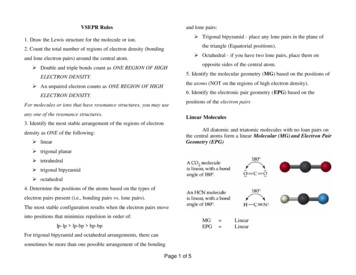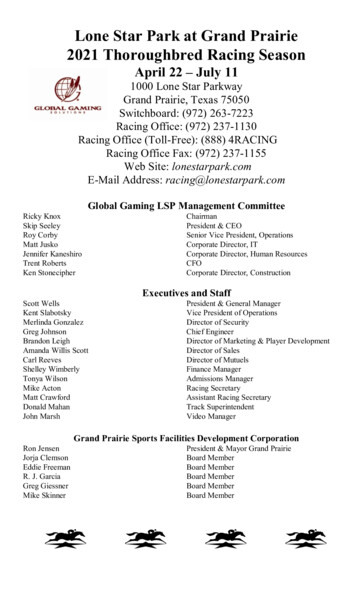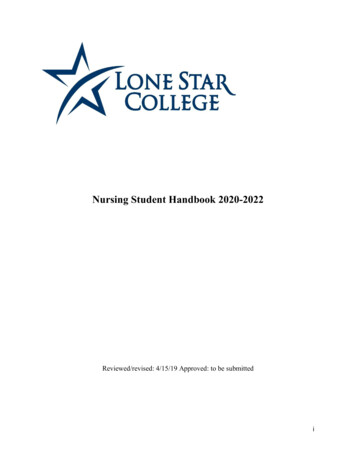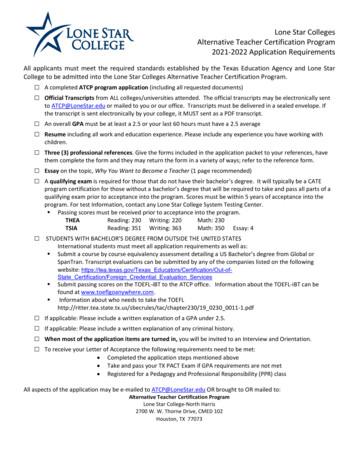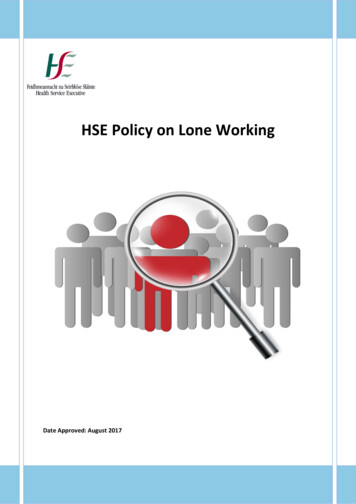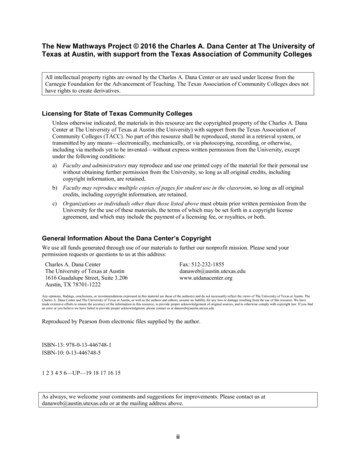
Transcription
The New Mathways Project 2016 the Charles A. Dana Center at The University ofTexas at Austin, with support from the Texas Association of Community CollegesAll intellectual property rights are owned by the Charles A. Dana Center or are used under license from theCarnegie Foundation for the Advancement of Teaching. The Texas Association of Community Colleges does nothave rights to create derivatives.Licensing for State of Texas Community CollegesUnless otherwise indicated, the materials in this resource are the copyrighted property of the Charles A. DanaCenter at The University of Texas at Austin (the University) with support from the Texas Association ofCommunity Colleges (TACC). No part of this resource shall be reproduced, stored in a retrieval system, ortransmitted by any means—electronically, mechanically, or via photocopying, recording, or otherwise,including via methods yet to be invented—without express written permission from the University, exceptunder the following conditions:a)Faculty and administrators may reproduce and use one printed copy of the material for their personal usewithout obtaining further permission from the University, so long as all original credits, includingcopyright information, are retained.b) Faculty may reproduce multiple copies of pages for student use in the classroom, so long as all originalcredits, including copyright information, are retained.c)Organizations or individuals other than those listed above must obtain prior written permission from theUniversity for the use of these materials, the terms of which may be set forth in a copyright licenseagreement, and which may include the payment of a licensing fee, or royalties, or both.General Information About the Dana Center’s CopyrightWe use all funds generated through use of our materials to further our nonprofit mission. Please send yourpermission requests or questions to us at this address:Charles A. Dana CenterThe University of Texas at Austin1616 Guadalupe Street, Suite 3.206Austin, TX 78701-1222Fax: ter.orgAny opinions, findings, conclusions, or recommendations expressed in this material are those of the author(s) and do not necessarily reflect the views of The University of Texas at Austin. TheCharles A. Dana Center and The University of Texas at Austin, as well as the authors and editors, assume no liability for any loss or damage resulting from the use of this resource. We havemade extensive efforts to ensure the accuracy of the information in this resource, to provide proper acknowledgement of original sources, and to otherwise comply with copyright law. If you findan error or you believe we have failed to provide proper acknowledgment, please contact us at danaweb@austin.utexas.edu.Reproduced by Pearson from electronic files supplied by the author.ISBN-13: 978-0-13-446748-1ISBN-10: 0-13-446748-51 2 3 4 5 6—UP—19 18 17 16 15As always, we welcome your comments and suggestions for improvements. Please contact us atdanaweb@austin.utexas.edu or at the mailing address above.ii
About the Charles A. Dana Center at The University of Texas at AustinThe Dana Center develops and scales math and science education innovations to support educators, administrators,and policy makers in creating seamless transitions throughout the K–14 system for all students, especially those whohave historically been underserved.We work with our nation’s education systems to ensure that every student leaves school prepared for success inpostsecondary education and the contemporary workplace—and for active participation in our modern democracy.We are committed to ensuring that the accident of where a student attends school does not limit the academicopportunities he or she can pursue. Thus, we advocate for high academic standards, and we collaborate with localpartners to build the capacity of education systems to ensure that all students can master the content described inthese standards.Our portfolio of initiatives, grounded in research and two decades of experience, centers on mathematics and scienceeducation from prekindergarten through the early years of college. We focus in particular on strategies forimproving student engagement, motivation, persistence, and achievement.We help educators and education organizations adapt promising research to meet their local needs and developinnovative resources and systems that we implement through multiple channels, from the highly local and personalto the regional and national. We provide long-term technical assistance, collaborate with partners at all levels of theeducation system, and advise community colleges and states.We have significant experience and expertise in the following: Developing and implementing standards andbuilding the capacity of schools, districts, andsystemsSupporting education leadership, instructionalcoaching, and teaching Designing and developing instructional materials,assessments, curricula, and programs for bridgingcritical transitionsConvening networks focused on policy, research, andpracticeThe Center was founded in 1991 at The University of Texas at Austin. Our staff members have expertise inleadership, literacy, research, program evaluation, mathematics and science education, policy and systemic reform,and services to high-need populations. We have worked with states and education systems throughout Texas andacross the country. For more information about our programs and resources, see our homepage atwww.utdanacenter.org.About the New Mathways ProjectThe NMP is a systemic approach to improving student success and completion through implementation ofprocesses, strategies, and structures based on four fundamental principles:1. Multiple pathways with relevant and challenging mathematics content aligned to specific fields of study2. Acceleration that allows students to complete a college-level math course more quickly than in thetraditional developmental math sequence3. Intentional use of strategies to help students develop skills as learners4. Curriculum design and pedagogy based on proven practiceThe Dana Center has developed curricular materials for three accelerated pathways—Statistical Reasoning,Quantitative Reasoning, and Reasoning with Functions I and II (a two course preparation for Calculus). Thepathways are designed for students who have completed arithmetic or who are placed at a beginning algebra level.All three pathways have a common starting point—a developmental math course that helps students developfoundational skills and conceptual understanding in the context of college-level course material.In the first term, we recommend that students also enroll in a learning frameworks course to help them acquire thestrategies—and tenacity—necessary to succeed in college. These strategies include setting academic and careergoals that will help them select the appropriate mathematics pathway.In addition to the curricular materials, the Dana Center has developed tools and services to support projectimplementation. These tools and services include an implementation guide, data templates and planning tools forcolleges, and training materials for faculty and staff.iii
AcknowledgmentsThe development of this course began with the formation of the NMP Curricular Design Team, who set the designstandards for how the curricular materials for individual NMP courses would be designed. The team members are:Richelle (Rikki) Blair, Lakeland CommunityCollege (Ohio)Rob Farinelli, College of Southern Maryland(Maryland)Amy Getz, Charles A. Dana Center (Texas)Roxy Peck, California Polytechnic StateUniversity (California)Sharon Sledge, San Jacinto College (Texas)Paula Wilhite, North Texas Community College(Texas)Linda Zientek, Sam Houston State University(Texas)The Dana Center then convened faculty from each of the NMP codevelopment partner institutions to provide inputon key usability features of the instructor supports in curricular materials and pertinent professional developmentneeds. Special emphasis was placed on faculty who need the most support, such as new faculty and adjunct faculty.The Usability Advisory Group members are:Ioana Agut, Brazosport College (Texas)Eddie Bishop, Northwest Vista College (Texas)Alma Brannan, Midland College (Texas)Ivette Chuca, El Paso Community College (Texas)Tom Connolly, Charles A. Dana Center (Texas)Alison Garza, Temple College (Texas)Colleen Hosking, Austin Community College(Texas)Juan Ibarra, South Texas College (Texas)Keturah Johnson, Lone Star College (Texas)Julie Lewis, Kilgore College (Texas)Joey Offer, Austin Community College (Texas)Connie Richardson, Charles A. Dana Center(Texas)Paula Talley, Temple College (Texas)Paige Wood, Kilgore College (Texas)Some of the content for this course is derived from the Quantway course, which was developed under aNovember 30, 2010, agreement by a team of faculty authors and reviewers contracted and managed by the CharlesA. Dana Center at The University of Texas at Austin under sponsorship of the Carnegie Foundation for theAdvancement of Teaching. Quantway is copyright 2011 by the Carnegie Foundation for the Advancement ofTeaching and the Charles A. Dana Center at The University of Texas at Austin. Statway and Quantway aretrademarks of the Carnegie Foundation for the Advancement of Teaching.Development of the Foundations for Mathematical Reasoning course was made possible by a grant from the KresgeFoundation. Additional funding and support for the New Mathways Project was provided by Carnegie Corporationof New York, Greater Texas Foundation, Houston Endowment, Texas legislative appropriations request, and TG.Any opinions, findings, conclusions, or recommendations expressed in this material are those of the author(s) and donot necessarily reflect the views of these funders or The University of Texas at Austin. This publication was alsosupported through a collaboration between the Charles A. Dana Center, Texas Association of Community Colleges,and Pearson Education, Inc.iv
Project Lead and AuthorsApril Andreas, associate professor, engineering, McLennan Community College (Texas)Pauline Chow, senior professor, mathematics, Harrisburg Area Community College (Pennsylvania)Christina Hoffmaster, instructor, Vernon College (Texas)Connie J. Richardson, advisory lead, Charles A. Dana CenterFrancisco Savina, curriculum lead and lead author, Charles A. Dana CenterRandell Simpson, resident mathematics instructor, Temple College (Texas)Charles A. Dana Center Project StaffAdam Castillo, graduate research assistantHeather Cook, project managerOphella C. Dano, lead production editorRachel Jenkins, consulting editorPhil Swann, senior designerSarah Wenzel, administrative associateAmy Winters, lead editor (freelance)Math Faculty Reviewers from the NMP Codevelopment TeamsAlamo Colleges–Northwest Vista College, San Antonio, TexasAustin Community College, Austin, TexasBrazosport College, Lake Jackson, TexasEl Paso Community College, El Paso, TexasKilgore College, Kilgore, TexasLone Star College–Kingwood, Kingwood, TexasMidland College, Midland, TexasSouth Texas College, McAllen, TexasTemple College, Temple, Texasv
Authors and Reviewers Contracted by the Dana CenterQuantwayTM version 1.0 (2011)Stuart Boersma, professor of mathematics, CentralWashington University (Washington)Mary Crawford-Mohat, associate professor inmathematics, Onondaga Community College(New York)Margaret (Peg) Crider, professor in mathematics,retired, Lone Star College (Texas)Caren Diefenderfer, professor of mathematics,Hollins University (Virginia)Amy Getz, manager of community collegeservices, Charles A. Dana Center, Universityof Texas at Austin (Texas)Michael Goodroe, lecturer of mathematics andlearning support liaison, Gainesville StateCollege (Georgia)Cinnamon Hillyard, assistant professor inmathematics, University of WashingtonBothell (Washington)Robert Kimball, professor in mathematics, retired,Wake Technical Community College (NorthCarolina)Deann Leoni, professor of mathematics, EdmondsCommunity College (Washington)Michael Lundin, professor of mathematics, CentralWashington University (Washington)Bernard L. Madison, professor in mathematicalsciences, University of Arkansas (Arkansas)Jeffrey Morford, professor of mathematics, HenryFord Community College (Michigan)Jane Muhich, managing director for communitycollege program development, and director ofproductive persistence, Carnegie Foundationfor the Advancement of Teaching (California)Julie Phelps, professor of mathematics, ValenciaCollege (Florida)Foundations version 1.0 (2013)Eileen Faulkenberry, associate professor ofmathematics, Tarleton State University (Texas)Christina Hoffmaster, Vernon College (Texas)Tom Faulkenberry, assistant professor ofmathematics, Tarleton State University (Texas)Liz Scott, San Augustine Independent School District(Texas)Jack Rotman, Lansing Community College(Michigan)Jeff Morford, Henry Ford Community College(Michigan)Constance Elko, Austin Community College (Texas)Pearson Education, Inc. StaffProject Manager Kathleen A. ManleyProject Management Team Lead Christina LepreProduct Marketing Manager Alicia FrankelSenior Author Support/Technology SpecialistJoe VetereRights and Permissions Project ManagerGina CheselkaProcurement Specialist Carol MelvilleAssociate Director of Design Andrea NixProgram Design Lead Beth PaquinComposition Dana BettezVice President, Editorial Jason JordanStrategic Account Manager Tanja EiseEditor in Chief Michael HirschSenior Acquisitions Editor Dawn GiovannielloEditorial Assistant Megan TrippDigital Instructional Designer Tacha GennarinoManager, Instructional Design Sara FinniganSenior Project Manager Dana ToneyDirector of Course Production, MyMathLabRuth BerryMathXL Content Developer Kristina Evansvi
PracticeAssignmentxiii--xxvii---How big Is a billion?Quantitative reasoning, large numbers1111.A-Building a learning communityStudent success focus--61.B1.C-How big is a billion? (continued)Quantitative reasoning, large numbers33131.C1.D-Building a learning community (continued)Student success focus--18-55292.APreviewAssignmentixLessonLesson PlanningSuggestionsIn-Class Activities(Student)In-Class Activitieswith AnswersContents--Curriculum Overview--Prep WeekIdeas for your syllabus1.A-1.BLesson Title and Description2.A2.ADoubling populationLarge numbers, doubling, ratesIntroduction to note taking2.B2.BScientific notationRepresenting numbers in scientific notation,converting back to standard notation87362.B2.C2.CRatios in water useLarge numbers, ratios, scientific notation119422.C2.D2.DAnalyzing water footprintsScientific notation, ratios1411472.D3.A3.ALarge numbers in the mediaMisinformation, strategies for testinginformation1713523.A3.BSeeking helpStudent success focusCampuses resources, seeking and offeringhelpNote: If this course is paired with the NewMathway Project's learning frameworkscourse, this lesson should be inserted afterthe frameworks class has completed theScavenger Hunt activity.211656-3.Bvii
Lesson PlanningSuggestionsPracticeAssignmentIn-Class Activities(Student)PreviewAssignmentIn-Class Activitieswith AnswersLesson3.C3.CEstimating sale pricesEstimation, benchmark percentages2317613.C3.D3.DCalculating sale pricesValue of estimation and calculation,calculating percentages2519663.D3.E3.EDeveloping self-regulationStudent Success focus, self assessment2721703.E4.A4.ABudgeting operationsUse of order of operations, properties, piecharts2923754.A4.B4.BBudgeting with spreadsheetsAlgebraic reasoning through the use ofspreadsheet formulas3225794.B4.C4.CGraph analysisIntroduction to visual displays, misleadingscale, relative change over time3527834.C4.D4.DUsing graphs to understand changeRelative size3829894.D5.A5.ADisplaying table dataStem-and-leaf plots, back-to-backcomparison4132945.A5.B5.BRelative frequency tablesConstruct and analyze frequency, relativefrequency, cumulative frequency4434995.B5.C5.CDisplaying data: HistogramsConvert frequency tables from 5.B intohistogramsNote: Optional data display project48371045.D5.DShapes of distributionsUsing dotplots to describe the shapes ofdistributions52391105.D6.AMeasures of central tendencyMean, median, mode, conclusions fromstatistical summaries, create data sets tomeet criterion56411146.A6.ALesson Title and Descriptionviii5.C
PreviewAssignmentIn-Class Activities(Student)Lesson PlanningSuggestionsPracticeAssignmentIn-Class Activitieswith AnswersLesson6.B6.BBrain powerStudent success focusHow the brain learns60431186.B6.C6.CMaking decisions with dataUse statistical summaries to make decisions62451226.C6.D6.DBoxplotsAnalyze a data set via 5-number summary64461266.D7.A7.AThe credit crunchReading strategies to understand financialinformation67481317.A7.B7.BMore credit crunchEstimate and calculate credit card interest69491377.B7.C7.CA taxing situationUnderstand and complete tax forms72511417.C7.D7.DA taxing situation (continued)Convert the tax instructions intomathematical expressions75531477.D8.A8.AWhat is the risk?Absolute and relative measures of risk,comparing fraction and decimal forms79551518.A8.B8.BAn apple a dayEvaluate measures of risk82571558.B8.C8.CReducing the riskPercentages, risk reduction86601608.C8.D8.DIs reducing the risk worth it?Absolute and relative change, ambiguity intalking about change in a quantity90621648.D9.A9.AComparing categorical dataTwo-way tables, importance of base value92641689.A9.B9.BInterpreting percentagesAnalysis of abstract information94661739.B9.C9.CDo you trust the test?Two-way tables, accuracy in test results98691779.C9.D9.DDo you trust the test? (Continued)Two-way tables, false-positive and falsenegative test results101711909.DLesson Title and Descriptionix
LessonPreviewAssignmentIn-Class Activitieswith AnswersIn-Class Activities(Student)Lesson ation densityRatios, proportional reasoning1047319510.A10.B10.BDensity proportionsScaling, dimensional analysis1067420110.B10.C10.CState population densities (optional)Estimation strategiesNote: Optional spreadsheet use1097520610.C10.D10.DApportionmentEffect of relative change on representation1147821310.D11.A11.AFormulating a planVariables, evaluate expressions (geometricformulas)1178121811.A11.B11.BThe costs of geometryBuilding on work with formulas1198222211.B11.C11.CModifying and combining formulasSemicircle area, volume1218422511.C12.A12.ATexting distanceDimensional analysis1238522912.A12.B12.BThe cost of drivingUnit rates to compare two options1258623412.B12.C12.CThe true cost of drivingMultiple pieces of information, multiple stepwork1278824112.C12.D12.DCan the true cost vary?Concrete to abstract approach to a system1309024612.D13.A13.AAlgebra reaction (optional)More complex, unfamiliar formulas1329125213.A13.B13.BBreaking down a formulaReading to understand/apply a complexformula1349325713.B13.C13.CAnalyzing change in variablesAnalyze effect of changing values of onevariable while other variables remain fixed1369526313.C13.D13.DAnalyzing change in variables (continued)Analyze effect of changing values of onevariable while other variables remain fixed1399626813.DLesson Title and Descriptionx
LessonPreviewAssignmentIn-Class Activitieswith AnswersIn-Class Activities(Student)Lesson PlanningSuggestionsPracticeAssignment14.A14.ABody mass indexEvaluate and record sequence of steps(multiplication and division only)1419727314.A14.B14.BTarget weightGiven target output, undo steps to find inputvalue1439827714.B14.C14.CBlood alcohol contentEvaluate and record sequence of steps(multiplication/division cing blood alcoholGiven target output, undo steps to find inputvalue14710228514.D15.A15.AProportional reasoning in artDetermine whether proportions areequivalent14910429115.A15.B15.BProportion solutionsSolve algebraic proportions15110630315.B15.C15.CSolving equationsAdditional practice with solving15310730715.C15.D15.DMore work with equations (optional)Equations chosen by instructor15610931115.D15.E15.EProportional viewing (optional)Equations chosen by instructor15711031615.E16.A16.ADescribing ratesSlope as a unit rate (y-intercept 0)15911232016.A16.B16.BComparing ratesCompare/contrast slopes (y-intercept 0)16311432416.B16.C16.CInterpreting changeCalculating slope from points,(y-intercept 0)16611632816.C16.D16.DWhere do we start?Calculating y-intercept by backing out theeffect of the variable term16811733216.D16.E16.EPredicting costsFormalizing the calculation of y-intercept17211933616.ELesson Title and Descriptionxi
LessonPreviewAssignmentIn-Class Activitieswith AnswersIn-Class Activities(Student)Lesson ssing linear relationshipsGraphs, tables, algebraic, and verbalrepresentations Intersecting lines17612134217.A17.B17.BMaking the callUsing multiple representations to makedecisions18012434617.B17.C17.CClose enoughScatterplots and trend lines18412635017.C17.D17.DPredicting budget increases (optional)Using a trend line to interpolate andextrapolate18913035617.D18.A18.APricing Your productDeveloping formulas for product markupsand discounts19213236018.A18.B18.BBacking out the sales taxDetermining the original amountNote: Optional mini-project available19513436618.B18.C18.CCompound interest makes centsDevelop exponential formula for annualinterest19813637218.C18.D18.DLong-term growthContinue work with annual compounding20013837618.D19.A19.AMore compoundingCompounding monthly then abstract togeneral form20214038119.A19.B19.BDepreciationExponential decayNote: Optional project available20414238619.B19.C19.CPayday loansEffect of extremely high interest20614339319.C19.D19.DNeither a borrower . . .Linear loan modelNote: This lesson can be combined with19.C by having different groups completeeach lesson.20814439919.D19.E19.ECredit card repayment (optional)Effect of making minimum payments21014540419.ELesson Title and Descriptionxii
Student ResourcesOverview15-Number Summary and Boxplots3Algebraic Terminology5Coordinate Plane6Dimensional Analysis8Equivalent Fractions11Four Representations of Relationships13Fractions, Decimals, Percentages15Length, Area, and Volume17Mean, Mode, Median21Multiplying and Dividing Fractions25Number-Word Combinations28Order of Operations29Probability, Chance, Likelihood, and Odds30Properties32Ratios and Fractions35Review Yourself for Exam 136Review Yourself for Exam 238Review Yourself for Exam 342Review Yourself for Exam 446Review Yourself for the Final Exam49Rounding and Estimation56Scientific Notation57Slope58Understanding Visual Displays of Information60Writing Principles62xiii
Foundations of Mathematical Reasoning, Instructor’s Curriculum OverviewxvCurriculum OverviewContents About Foundations of Mathematical ReasoningStructure of the curriculumStructure of the Suggested Instructor Notes for the lessonsConstructive perseverance levelMaterials listTable of contents informationThe role of the preview and practice assignmentsResource materials for studentsLanguage and literacy skillsContent outline of the curriculumCurriculum design standardsPrerequisite assumptionsLearning goalsContent learning outcomesAbout Foundations of Mathematical ReasoningFoundations of Mathematical Reasoning is a semester-long, quantitative literacy-based coursedesigned to provide students with the skills and conceptual understanding to succeed in acollege-level statistics, quantitative literacy, or STEM path algebraic reasoning course.Foundations of Mathematical Reasoning is organized around big mathematical and statisticalideas. The course will help students develop conceptual understanding and acquire multiplestrategies for solving problems (as described in the NMP Curriculum Design Standards asdescribed on page xxx). The course will prepare students for success in future courses and willhelp them develop skills for the workplace and as productive citizens.Foundations of Mathematical Reasoning is typically taught as a developmental-level course thatis designed to accelerate students to college-level mathematics.Course structure and contact hoursFoundations is designed to be taught in a one-semester course with 4 student contact hours perweek or in a quarter system with an equivalent number of contact hours. Colleges may chooseto offer this as a 4-credit course or as a combination of course credits and lab credits.Regarding lab credits, it is important to note that the curriculum is not designed for instruction inseparate and distinct lab meetings. Rather, the intent is for the instructor to use all 4 contacthours for classroom instruction.Copyright 2016, The Charles A. Dana Center at the University of Texas at Austin
xviFoundations of Mathematical Reasoning, Instructor’s Curriculum OverviewActive learning design standards are evident in each lesson. Students will be expected toactively do mathematics—such as analyzing data, constructing hypotheses, solving problems,reflecting on their work, and making connections among and between mathematical concepts.Structure of the curriculumThe curriculum is designed in 25-minute learning episodes, which can be pieced together toconform to any class length. These short bursts of active learning, combined with whole classdiscussion and summary, produce increased memory retention.1Prerequisite assumptionsStudents enrolling in Foundations of Mathematical Reasoning should be able to do thefollowing: Demonstrate procedural fluency with real number arithmetic operations (e.g., basicoperations, comparing, contrasting), use arithmetic operations to represent real-worldscenarios, and use those operations to solve stated problems. Use graphical representations on a real number line to demonstrate fluency whenordering numbers, to represent operations (e.g., addition, subtraction, doubling, halving,averaging), and to represent fractions and decimals. Demonstrate a basic understanding and familiarity with fractions, decimals, andpercentages. Procedural competency for representing each number form and movingfrom one to the other is desired upon enrollment in this course, but the student may alsoneed to work with materials outside of class to review basic concepts and build basicskills.1Sources: Buzan, T. (1989). Master your memory (Birmingham: Typersetters); Buzan, T. (1989). Useyour head (London: BBC Books); Sousa, D. (2011). How the brain learns, 4th ed. (Thousand Oaks, CA:Corwin); Gazzaniga, M., Ivry, R. B., & Mangun, G. R. (2002). Cognitive neuroscience: The biology of themind, 2nd ed. (New York: W.W. Norton); Stephane, M., Ince, N., Kuskowski, M., Leuthold, A., Tewfik, A.,Nelson, K., McClannahan, K., Fletcher, C., & Tadipatri, V. (2010). Neural oscillations associated with theprimary and recency effects of verbal working memory. Neuroscience Letters, 473, 172–177.); Thomas,E. (1972). The variation of memory with time for information appearing during a lecture. Studies in AdultEducation, 57–62.Copyright 2016, The Charles A. Dana Center at the University of Texas at Austin
Foundations of Mathematical Reasoning, Instructor’s Curriculum OverviewxviiStructure of the Suggested Instructor Notes for the lessonsThe main features of the Suggested Instructor Notes for the lessons are: Overview and student objectives – includes the constructive perseverance level of thelesson, the learning outcomes, and goals addressed. Suggested resources and preparation – includes technology needs, physicalmaterials, and preparation needed for activities. A consolidated materials list is includedin the next section. Prerequisite assumptions – lists the skills that students need to be prepared for thelesson. The same list is given to the students in the preview assignment. Students areasked to rate their confidence level on each skill. If they struggle with transference ofthese skills into the new context of the lessons, the instructor can refer back to thepreview questions to help students recognize that they have done similar problems. Making connections – details the main concepts that are extensions of earlier work inthe course as well as connections forward in this course and later courses. Background context – includes the main points of any informational pieces that weregiven to students in preview assignments. For example, the preview assignment forLesson 13, Part B contains information about the grade of a road. The main points ofthat information are included in the Background context section of the SuggestedInstructor Notes for that lesson so that the instructor does not have to look through thehomework to determine what students have read. Suggested instructional plan – includes excerpts of Student Pages and the following:oFrame the lesson – suggestions to elicit prior student knowledge, focus discussion,or ask for a prediction.oLesson activities – detailed suggestions for probing questions for students or groups,guiding questions for class discussions, and literacy supports.oWrap-up for the day or transition to the next activity.The Suggested Instructor Notes do not summarize all ideas of the lesson; rather, they areintended to facilitate the inclusion of broader ideas. Instead of having the instructor inform themof the connections, the goal is to have students actively engaged in making those connections.This is a challenging skill that will be developed throughout the course. Early discussions arelikely to be slow-starting and require a great deal of prompting. Instructors can build on whatstudents say and can model how to express these abstract concepts. The facilitation promptsprovide instructors with ideas on how to promote student discussion. As the explicit connectionsemerge, the instructor should record the ideas on the board and, especially early in the course,make sure students record the ideas in their notes.Copyright 2016, The Charles A. Dana Center at the University of Texas at Austin
xviiiFoundations of Mathematica
All three pathways have a common starting point—a developmental math course that helps students develop . These strategies include setting academic and career . Alamo Colleges-Northwest Vista College, San Antonio, Texas Austin Community College, Austin, Texas Brazosport College, Lake Jackson, Texas .


